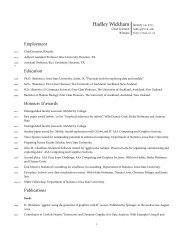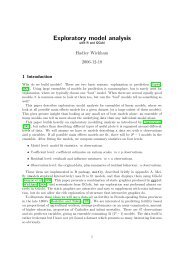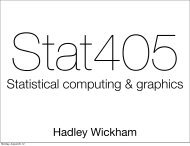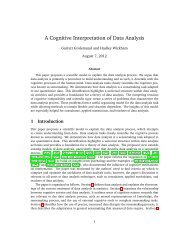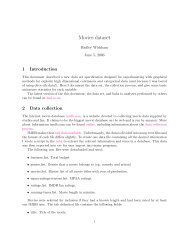Glaciers Melt as Mountains Warm: A Graphical Case Study
Glaciers Melt as Mountains Warm: A Graphical Case Study
Glaciers Melt as Mountains Warm: A Graphical Case Study
You also want an ePaper? Increase the reach of your titles
YUMPU automatically turns print PDFs into web optimized ePapers that Google loves.
<strong>Glaciers</strong> <strong>Melt</strong> <strong>as</strong> <strong>Mountains</strong> <strong>Warm</strong>: A <strong>Graphical</strong> C<strong>as</strong>e <strong>Study</strong><br />
J. Hobbs, H. Wickham, H. Hofmann, D. Cook<br />
a Department of Statistics, Iowa State University,<br />
Ames IA 50011, United States<br />
For the 2006 ASA Data Exposition, we created graphics that, in the legacy of John<br />
Tukey, tried to “force the unexpected upon us” (Tukey, 1972). The data are geographic<br />
and atmospheric me<strong>as</strong>ures on a coarse 24 by 24 grid covering Central America, me<strong>as</strong>ured<br />
monthly over the course of six years from January 1995 to December 2000.<br />
Using conventional static graphics and some less conventional interactive graphics, we<br />
are able to find familiar features in the data, such <strong>as</strong> se<strong>as</strong>onal patterns, spatial correlations,<br />
El Niño events, <strong>as</strong> well <strong>as</strong> some more surprising results, some that corroborate current<br />
events in the news.<br />
1. Introduction<br />
Data analysis is messy! Real data sets are rarely perfect and may need multiple p<strong>as</strong>ses<br />
to ensure high quality, and to converge on findings. At every stage, there are many possible<br />
next steps and our path w<strong>as</strong> guided by intuition, knowledge of the phenomenon and p<strong>as</strong>t<br />
experience. Many steps led to dead ends, and most plots ended up in the w<strong>as</strong>teb<strong>as</strong>ket.<br />
This may sound disorganized, but even highly improvisational data exploration does have<br />
some structure. Our approach h<strong>as</strong> these components:<br />
a ∗<br />
1. Refining the questions, deriving expectations<br />
2. Organizing the data<br />
3. Plotting the data<br />
4. Modeling<br />
5. Incorporating other data<br />
6. Presenting findings<br />
The process is not linear, and we returned to re-do, and re-work, the analysis at different<br />
stages. Chatfield (1995) h<strong>as</strong> a good description of this process.<br />
The Expo data w<strong>as</strong> daunting! It w<strong>as</strong> complicated by several contexts: spatial, temporal<br />
and multivariate. We could have simplified the data by reducing the study to one variable,<br />
one time point or one location, but instead we tackled the entire data. Our analysis took<br />
many, many hours of labor, re-processing, with dead-ends, lots of plots, discussion, and<br />
sharing of code and discoveries.<br />
∗ This work h<strong>as</strong> been partly supported by the NSF VIGRE Grant0091953.<br />
1
2 Hobbs et al.<br />
Rather than simply presenting our findings in the Expo data, this paper also describes<br />
the process that led to these discoveries. We think that the process will be interesting<br />
reading, both <strong>as</strong> an example of exploratory data analysis and <strong>as</strong> a story of the ch<strong>as</strong>e for<br />
discovery.<br />
2. Getting started<br />
2.1. Refining the questions, deriving expectations<br />
The initial announcement for the Data Expo provided limited general information about<br />
the data set and the objectives for analysis. Specifics included the locations and dates<br />
of the observations and brief descriptions of the variables. Accompanying the description<br />
w<strong>as</strong> a set of four general questions about the data set:<br />
• What are the important relationships between variables?<br />
• Are there important trends?<br />
• Are there important groupings or clusters?<br />
• Any unusual locations or time periods?<br />
Armed with this, we attempted to frame some ide<strong>as</strong> suggested in these questions into<br />
some hypotheses about what we might see in the data:<br />
• The area covers the equatorial Pacific Ocean. We should see El Niño and La Niña<br />
effects on the temperature variables, and perhaps other variables, for events that<br />
occurred between 1995 and 2000.<br />
• Data from the same month will show correlations between years (se<strong>as</strong>onal patterns).<br />
• Se<strong>as</strong>onal trends will be different for sea versus land are<strong>as</strong> and the northern hemisphere<br />
versus the southern hemisphere.<br />
• Data from neighboring locations will be correlated.<br />
To further refine these hypotheses and to develop others, we investigated the way the<br />
variables were defined in more detail than w<strong>as</strong> given. We also examined what different<br />
climate terms such <strong>as</strong> El Niño mean.<br />
2.2. Investigating the data sources<br />
From the variable descriptions, it appeared that the observations came from at le<strong>as</strong>t<br />
two satellite products archived by the International Satellite Cloud Climatology Project<br />
(ISCCP). The pressure, ozone and near-surface air temperature variables were derived<br />
from the TIROS Operational Vertical Sounder (TOVS). The remaining variables, cloud<br />
cover and temperature from clear-sky composite, were likely derived from the Gridded<br />
Cloud Product (Rossow and Schiffer, 1991).<br />
The radiation intensity, or brightness temperature, TB, observed by a satellite is a function<br />
of the surface temperature Tsfc, the vertical temperature profile in the atmosphere<br />
T (z ′ ) and some constant quantities. The relationship is described by the b<strong>as</strong>ic equation<br />
of radiometry (e.g. Ulaby et al. (1981)):<br />
TB = ɛTsfcɛ −τ(0,∞) z<br />
+<br />
0<br />
κaT (z ′ )ɛ −τ(z′ ,z) dz ′ ,
<strong>Glaciers</strong> <strong>Melt</strong> <strong>as</strong> <strong>Mountains</strong> <strong>Warm</strong> 3<br />
where τ is the optical depth, κa is the absorption coefficient, z is the height at the top of<br />
the atmosphere, and ɛ is the emissivity.<br />
TOVS is calibrated to give a vertical profile of a number of variables, including temperature<br />
and ozone. The Gridded Cloud Product is calibrated to distinguish cloud properties<br />
and surface characteristics in the absence of clouds. Thus, the two products can give different<br />
pictures of surface temperature. In addition, values of the constants can change<br />
with changing land surface characteristics, creating several possible sources of error.<br />
2.3. Organizing the data<br />
The data were provided <strong>as</strong> a set of individual files, one file for each of the variables for<br />
a single month—72 files for each variable—each one formatted <strong>as</strong> follows:<br />
VARIABLE : Mean low cloud amount (%)<br />
FILENAME : ISCCPMonthly_avg.nc<br />
FILEPATH : /usr/local/fer_data/data/<br />
SUBSET : 24 by 24 points (LONGITUDE-LATITUDE)<br />
TIME : 16-JAN-1995 00:00<br />
113.8W 111.2W 108.8W 106.2W 103.8W 101.2W 98.8W ...<br />
27 28 29 30 31 32 33<br />
36.2N / 51: 7.50 7.00 7.00 7.00 11.00 14.50 25.50 ...<br />
33.8N / 50: 11.50 11.50 9.50 8.50 12.50 17.50 27.50 ...<br />
...<br />
The four of us came up with different ways to organize the data, mainly triggered<br />
by different ways each of us w<strong>as</strong> thinking about the data, emph<strong>as</strong>izing the spatial, the<br />
temporal or the multivariate <strong>as</strong>pect. The data organization heavily influenced our choices<br />
of methods to analyze the data.<br />
Both of our main approaches are in rectangular form, which we found to be the most<br />
convenient overall. Even though R does allow the creation of data cubes—with two dimensions<br />
for the spatial components and one dimension for the temporal component of<br />
each variable—it is not e<strong>as</strong>y to use the data in this form afterwards.<br />
The two rectangular formats that we ended up using most often can be described <strong>as</strong> a<br />
“short and wide” version of the data set and a “long and thin” version.<br />
In “wide and short,” the focus is on the locations. It therefore h<strong>as</strong> 576 observations,<br />
one for each location, and all the other <strong>as</strong>pects, such <strong>as</strong> elevation and all monthly me<strong>as</strong>urements<br />
of ozone, temperatures, and cloud cover, are encoded in columns:<br />
Longitude Latitude chJan95 chFeb95 chMar95 chApr95 ...<br />
-113.75 -21.25 0.5 1 2 4 ...<br />
-113.75 -18.75 2.5 0.5 1 0 ...<br />
...<br />
That is, each of the original files corresponds to one column of this data set. This version<br />
of the data set allows the use of parallel coordinate plots to emulate time series for each<br />
location, <strong>as</strong> seen in Figures 2, 3, 4, 6 and 7.
4 Hobbs et al.<br />
“Long and thin” h<strong>as</strong> 72 × 576 rows, i.e˙each location is repeated for every time index (all<br />
72 months). Me<strong>as</strong>urements such <strong>as</strong> elevation, which is only recorded once, are repeated<br />
accordingly to match the other variables:<br />
x y Lat Long elev time Year Month ts tsa_tovs ...<br />
1 1 36.25 -113.75 1526.25 1 1995 1 272.7 272.1 ...<br />
1 2 33.75 -113.75 612.94 1 1995 1 279.5 282.2 ...<br />
Note that a new variable called time w<strong>as</strong> created to index time from January 1995 to<br />
December 2000. This is then used <strong>as</strong> the x-position to plot time series. This version of<br />
the data allows us to study the multivariate <strong>as</strong>pects of the data and is the supporting<br />
structure of results in Figures 5, 8 and 9.<br />
To keep the geographic context of the data in the forefront, we pieced together a map<br />
of the region from Google maps and pinned this to the wall. It is shown in Figure 1.<br />
Figure 1. Map of the geographic area where the Expo data w<strong>as</strong> me<strong>as</strong>ured, created from<br />
Google maps.
<strong>Glaciers</strong> <strong>Melt</strong> <strong>as</strong> <strong>Mountains</strong> <strong>Warm</strong> 5<br />
3. Plotting the data<br />
3.1. High altitude temporal anomalies<br />
Data exploration often uncovers problems with the data, and this data set is no exception.<br />
A look at time series of pressure for each location reveals a problem: between<br />
May and June of 1998, several locations exhibit a dramatic incre<strong>as</strong>e in pressure, with a<br />
number of locations showing an incre<strong>as</strong>e of over 100 millibars. Holding all other variables<br />
constant, this would be equivalent to a change in elevation of over 1 kilometer! Using the<br />
linked graphics in Figure 2, we found that all of the problematic locations were at high<br />
elevations.<br />
Pressure<br />
600 700 800 900 1000<br />
Jan 1995 Jan 1996 Jan 1997 Jan 1998 Jan 1999 Jan 2000 −110 −100 −90 −80 −70 −60<br />
time<br />
Latitude<br />
−20 −10 0 10 20 30<br />
● ●<br />
●<br />
●<br />
● ● ● ● ● ● ● ● ● ● ● ● ● ● ● ● ● ● ● ●<br />
● ● ●<br />
●<br />
●<br />
● ● ● ● ● ● ● ● ● ● ● ● ● ● ● ● ● ● ●<br />
● ● ●<br />
●<br />
● ● ● ● ● ● ● ● ● ● ● ● ● ● ● ● ● ● ● ●<br />
● ● ● ●<br />
●<br />
● ● ● ● ● ● ● ● ● ● ● ● ● ● ● ● ● ● ●<br />
● ● ●<br />
●<br />
●<br />
●<br />
● ● ● ● ● ● ● ● ● ● ● ● ● ● ● ● ● ●<br />
● ● ● ●<br />
●<br />
●<br />
●<br />
● ● ● ● ● ● ● ● ● ● ● ● ● ● ● ● ●<br />
● ● ● ● ●<br />
●<br />
● ● ● ● ● ● ● ● ● ● ● ● ● ● ● ● ● ●<br />
● ● ● ● ● ●<br />
●<br />
●<br />
● ● ● ● ● ● ● ● ● ● ● ● ● ● ● ●<br />
● ● ● ● ● ● ● ● ● ● ● ● ● ● ● ● ● ● ● ● ● ● ● ●<br />
● ● ● ● ● ● ● ● ● ● ● ● ● ● ● ● ● ● ● ● ● ● ● ●<br />
● ● ● ● ● ● ● ● ● ● ● ● ● ● ● ● ● ● ● ● ● ● ● ●<br />
● ● ● ● ● ● ● ● ● ● ● ● ● ● ● ● ● ● ● ● ● ● ● ●<br />
● ● ● ● ● ● ● ● ● ● ● ● ● ● ● ● ●<br />
● ● ● ● ● ● ●<br />
● ● ● ● ● ● ● ● ● ● ● ● ● ● ● ●<br />
●<br />
● ● ● ● ● ● ●<br />
● ● ● ● ● ● ● ● ● ● ● ● ● ● ● ●<br />
● ● ● ● ● ● ● ●<br />
● ● ● ● ● ● ● ● ● ● ● ● ● ● ●<br />
● ● ● ● ● ● ● ● ●<br />
● ● ● ● ● ● ● ● ● ● ● ● ● ● ●<br />
● ● ● ● ● ● ● ● ●<br />
● ● ● ● ● ● ● ● ● ● ● ● ● ● ●<br />
● ● ● ● ● ● ● ● ●<br />
● ● ● ● ● ● ● ● ● ● ● ● ● ● ● ●<br />
● ● ● ● ● ● ● ●<br />
● ● ● ● ● ● ● ● ● ● ● ● ● ● ●<br />
●<br />
● ● ● ● ● ● ● ●<br />
● ● ● ● ● ● ● ● ● ● ● ● ● ● ● ●<br />
●<br />
●<br />
● ● ● ● ● ●<br />
● ● ● ● ● ● ● ● ● ● ● ● ● ● ● ● ●<br />
●<br />
●<br />
●<br />
● ● ● ●<br />
● ● ● ● ● ● ● ● ● ● ● ● ● ● ● ● ● ●<br />
●<br />
●<br />
●<br />
● ● ●<br />
● ● ● ● ● ● ● ● ● ● ● ● ● ● ● ● ● ● ●<br />
● ● ● ● ●<br />
Figure 2. Time series of pressure values for each location. Locations with problematic<br />
pressure changes (change of more than 80 millibars) are highlighted in the time series<br />
plot and the scatterplot of latitude and longitude. Problematic locations turn out to be<br />
in high-altitude are<strong>as</strong> of the Rockies and Andes.<br />
Looking at temperature in a similar way also revealed several unusual locations. The<br />
parallel coordinate plot in Figure 3 shows the temperature profile of all monthly averages,<br />
with location 36.25 ◦ N, 103.75 ◦ W highlighted. After June of 1998 the temperature<br />
profile is conspicuously regular; closer inspection reveals that the monthly temperature<br />
patterns are repeating in subsequent years. This gave us a strong re<strong>as</strong>on to suspect that<br />
these air temperature values were imputed and not observed. Another three locations;<br />
18.75 ◦ S, 68.75 ◦ W; 21.25 ◦ S, 66.25 ◦ W; and 18.75 ◦ S, 66.25 ◦ W; show the same pattern. The<br />
imputation used is se<strong>as</strong>onal and while it does a re<strong>as</strong>onably good job for the first location,<br />
the imputed values for location 21.25 ◦ S, 66.25 ◦ W are very different from the observed<br />
temperature values, <strong>as</strong> shown in Figure 4.<br />
Because we did not have access to the underlying raw data, we could not investigate<br />
this problem further, let alone fix it, so for the rest of the analysis we will ignore pressure<br />
and will be wary of the temperature me<strong>as</strong>urements.<br />
We can look at the pressure data in another way, by showing small time series of<br />
pressure at location while maintaining the spatial structure, <strong>as</strong> in Figure 5. The figure<br />
w<strong>as</strong> created using a manual correlation tour Cook and Buja (1997); Cook et al. (2006),<br />
with the time rotated into the horizontal direction and pressure rotated into the vertical<br />
Longitude
6 Hobbs et al.<br />
Figure 3. Temperature profiles of all locations. Location 36.25 ◦ N, 103.75 ◦ W (in the<br />
Rockies) is highlighted. The regular pattern of values after June 1998 are an indication<br />
that these values are imputed and not observed.<br />
Figure 4. Temperature profiles of all locations. Highlighted is location 21.25 ◦ S, 66.25 ◦ W<br />
(in the Andes of Peru). After June 1998 temperature values are probably imputed but<br />
do not reflect previous temperature values well.<br />
direction. The plots in the figure show the results of the sequence of rotations.<br />
Again we can see that the locations where there is a problem with pressure are all in<br />
the high-altitude are<strong>as</strong>. For most of the study area, pressure values are fairly constant<br />
over time, but in the higher altitudes, pressure values jump around in the middle of the<br />
time series. We can zoom in on one location by linking this plot to a plot of all the time<br />
series and brushing one location (bottom plot). We have highlighted a location where<br />
some se<strong>as</strong>onal pattern is visible for the first three years and then the pressure values jump<br />
and stay constant for most of the latter three years.<br />
This approach w<strong>as</strong> used with other variables besides pressure. From these we learned<br />
that there is something odd about the relationship between the two temperature variables<br />
in the high altitudes, and cloud patterns change in the Pacific during an El Niño event.<br />
The video accompanying the poster illustrates these findings.
<strong>Glaciers</strong> <strong>Melt</strong> <strong>as</strong> <strong>Mountains</strong> <strong>Warm</strong> 7<br />
Figure 5. Using a correlation tour to lay out small time series at each location. Pressure<br />
values are flat over much of the spatial domain, but in the high altitude are<strong>as</strong> there is a<br />
strange jump or split in values, after the middle of the time series.
8 Hobbs et al.<br />
3.2. Spatio-temporal trend in ozone<br />
A cl<strong>as</strong>sical approach to displaying spatial data is to use color to represent the numerical<br />
value of a me<strong>as</strong>ured variable on a map or geographic area. We used image plots in R to<br />
plot monthly averages by location. Figure 6 shows the whole set of maps of monthly ozone<br />
averages, with color values are scaled across all maps, enabling us to make comparisons<br />
across all plots <strong>as</strong> well <strong>as</strong> detecting patterns within.<br />
The layout in figure 6 makes comparisons between successive months e<strong>as</strong>y (except for<br />
the unfortunate break between December and January) and at the same time allows<br />
comparisons of ozone levels for the same month in successive years. This identifies the<br />
ozone values of March 1997 <strong>as</strong> elevated with respect to both February and April of the<br />
same year <strong>as</strong> well <strong>as</strong> the values in March of all the other years.<br />
Looking at individual plots, we can see a spatial trend: high values are found farther<br />
from the equator. Reading across a row, we can see a distinct se<strong>as</strong>onal trend: in the<br />
months of June-October, ozone levels incre<strong>as</strong>e from the north towards the equator, and<br />
to some extent in the south also. Finally, reading down columns, we can see differences<br />
between years: in 2000 the ozone levels have dropped again by September, while in 1995<br />
they stay high through October.<br />
Figure 6. A cl<strong>as</strong>sical approach to plotting spatio-temporal data: ozone values shown using<br />
color on the spatial coordinates, with separate plots for each date.
<strong>Glaciers</strong> <strong>Melt</strong> <strong>as</strong> <strong>Mountains</strong> <strong>Warm</strong> 9<br />
3.3. The El Niño effect<br />
In late 1997 and early 1998, sea surface temperatures in the equatorial Pacific remained<br />
unse<strong>as</strong>onably high. We can see this in the linked time series of near-surface temperature<br />
and spatial location plots in Figure 7. This phenomenon is known <strong>as</strong> El Niño, and is<br />
reported to occur every 2-7 years.<br />
temperature<br />
270 280 290 300 310<br />
Jan 1995 Jan 1996 Jan 1997 Jan 1998 Jan 1999 Jan 2000<br />
time<br />
-110 -100 -90 -80 -70 -60<br />
Figure 7. For the location marked in the Pacific Ocean in the scatterplot to the right the<br />
temperatures stay unse<strong>as</strong>onably high during the Winter of 1997 and Spring 1998. This<br />
phenomenon is known <strong>as</strong> El Niño.<br />
Latitude<br />
-20 -10 0 10 20 30<br />
~/Documents/Data-Exposition-2006/data<br />
Figure 8 explores temporal trends in two locations: one at a northern latitude and<br />
another in the equatorial Pacific. We brush in the spatial domain and examine the<br />
changes in the time series. We see that at more northern latitudes there is a stronger<br />
se<strong>as</strong>onal trend in temperature and ozone. Low cloud cover exhibits more se<strong>as</strong>onal trend<br />
near the equator, which is noticeably absent during the 1997-8 El Niño event. Pressure<br />
is flat in both regions, <strong>as</strong> expected for low elevation data.<br />
Longitude
10 Hobbs et al.<br />
Figure 8. Two views of the data, with linked brushing: one of the geographic locations,<br />
and the other of multiple time series of the me<strong>as</strong>ured variables. At more northern latitudes<br />
there is more se<strong>as</strong>onal trend in temperature and ozone. Low cloud cover exhibits more<br />
se<strong>as</strong>onal trend near the equator, and it is noticeably absent during the 1997-8 El Niño<br />
event. Pressure is flat in both regions, <strong>as</strong> expected.
<strong>Glaciers</strong> <strong>Melt</strong> <strong>as</strong> <strong>Mountains</strong> <strong>Warm</strong> 11<br />
3.4. Multivariate relationships<br />
Figure 9 and Table 1 help us examine the pairwise relationships between variables.<br />
The two temperature variables are fairly strongly <strong>as</strong>sociated. There are a couple of points<br />
where there is a big difference between the two, and these are brushed to examine in other<br />
views. Further exploration reveals that the largest differences occur on the edges of the<br />
spatial region so are probably errors created from the original data processing.<br />
It is more difficult to describe the relationships between other pairs of variables. Pressure<br />
h<strong>as</strong> little <strong>as</strong>sociation with temperature or ozone. Temperature h<strong>as</strong> some <strong>as</strong>sociation<br />
with ozone. The clouds have something of a constrained relationship, for example if there<br />
is a lot of high cloud cover there tends to be little low cloud cover. To learn more, we<br />
need to condition on time points or locations or both.<br />
Figure 9. Examining all pairwise relationships using a scatterplot matrix of me<strong>as</strong>ured<br />
variables.
12 Hobbs et al.<br />
Table 1<br />
Correlation matrix for the me<strong>as</strong>ured variables.<br />
ts tsa ps o3 ca low ca med ca high<br />
ts 1.00 0.81 0.35 -0.21 -0.07 -0.31 0.04<br />
tsa 0.81 1.00 0.50 -0.35 -0.20 -0.09 0.22<br />
ps 0.35 0.50 1.00 -0.06 0.30 -0.22 -0.09<br />
o3 -0.21 -0.35 -0.06 1.00 -0.01 -0.03 -0.08<br />
ca low -0.07 -0.20 0.30 -0.01 1.00 -0.42 -0.54<br />
ca med -0.31 -0.09 -0.22 -0.03 -0.42 1.00 0.62<br />
ca high 0.04 0.22 -0.09 -0.08 -0.54 0.62 1.00<br />
4. Modeling<br />
Once we have identified strong patterns, it is useful to remove them and see what<br />
remains. In this section we model some of the gross patterns and see what subtle features<br />
are left.<br />
4.1. Removing se<strong>as</strong>onal trends<br />
To focus on long-term trends, it is necessary to remove the strong se<strong>as</strong>onal pattern. We<br />
fit a model to each location; with an intercept, a trend in time and a combination of sine<br />
and cosine fits to accommodate for se<strong>as</strong>onality.<br />
Y = µ + αt + β1 sin(m) + β2 cos(m) + ε, ε ∼ MV N(0, σ 2 I)<br />
where Y temperature (in K)<br />
t index of time, t = 1, ..., 72<br />
m index of month, m = 2iπ/12, i = 1, ..., 12<br />
µ average temperature<br />
α monthly incre<strong>as</strong>e in average temperature (in K)<br />
β1, β2<br />
amplitude of temperature<br />
(α, β1, β2) ∼ N(0, Σ)<br />
The overall fit is good, R 2 = 0.91 and ˆσ = 1.47.<br />
The plot in Figure 10 shows the time trend models <strong>as</strong> lines and residuals from the fit <strong>as</strong><br />
points, fitted for each location to the near-surface temperature. Many locations in South<br />
America exhibit an incre<strong>as</strong>ing trend over time, with some locations showing incre<strong>as</strong>es of<br />
several degrees per year! Many locations in the equatorial Pacific exhibit a “bump” in<br />
the residual pattern late 1997 and early 1998. This anomaly is the El Niño event.
<strong>Glaciers</strong> <strong>Melt</strong> <strong>as</strong> <strong>Mountains</strong> <strong>Warm</strong> 13<br />
Figure 10. Time trends (lines) and residuals (points) of de-se<strong>as</strong>onalized temperature values<br />
are shown for each location. Large incre<strong>as</strong>es in temperature are <strong>as</strong>sociated with high<br />
altitude. Some of the highest incre<strong>as</strong>es, particularly in South America, are in locations of<br />
glaciers (marked by black points). The scatterplots below show the temperature values<br />
(points) and fitted values (line) for two individual locations. The scatterplot on the right<br />
shows one of the locations flagged earlier in section 3.1. The decre<strong>as</strong>e in temperature is<br />
artificially introduced by the imputation.
14 Hobbs et al.<br />
4.2. Clustering ozone<br />
Section 3.2 looked at spatial patterns in ozone, conditioned on time. Similarly, it is<br />
worthwhile to look at temporal patterns, conditioned on location. The small multiples in<br />
the software Gauguin (Gribov et al., 2006) provide one way of doing this, shown in Figure<br />
11. (This analysis used the wide short form of the data.) At each location, a star glyph<br />
displays the amount of ozone me<strong>as</strong>ured every month. This graphic allows us to compare<br />
patterns at both global and local scales.<br />
Different shapes represent different patterns at a given location: large circular icons<br />
indicate high values at all time points; flower shapes indicate se<strong>as</strong>onal variability, with<br />
peaks and dips at the same time each year. Colors categorize the locations into 10 different<br />
temporal patterns. These patterns were created using hierarchical clustering.<br />
Global patterns can be seen by looking at the glyphs en m<strong>as</strong>se; try squinting your eyes<br />
or looking at the figure from a distance. Ozone levels are highest furthest from the equator<br />
and have less se<strong>as</strong>onal variability in the Northern Hemisphere.<br />
Latitude<br />
Longitude<br />
Figure 11. Star glyphs of monthly ozone values between 1995 and 2000. Left: the glyphs<br />
are placed according to latitude and longitude. Right: star and profile glyphs showing<br />
the 10 different clusters.<br />
4.3. Clustering into local climates<br />
Cluster analysis can help us learn about local climates in the larger geographic region.<br />
Ideally, the clustering is done using all of the me<strong>as</strong>ured variables, not only ozone. We
<strong>Glaciers</strong> <strong>Melt</strong> <strong>as</strong> <strong>Mountains</strong> <strong>Warm</strong> 15<br />
found that, although Gauguin can theoretically do this, it w<strong>as</strong> too slow. Instead, we used<br />
R to cluster the data using all of the variables.<br />
A hierarchical cluster analysis w<strong>as</strong> performed on all variables other than pressure, using<br />
the “short and wide” form of the data. Variables were standardized to have zero mean<br />
and unit variance. Interpoint distance w<strong>as</strong> me<strong>as</strong>ured by Euclidean distance and Ward’s<br />
linkage w<strong>as</strong> used to describe distances between clusters. Ten clusters were chosen b<strong>as</strong>ed<br />
on the dendrogram and from our own limited knowledge about the geographical regions.<br />
The cluster cl<strong>as</strong>sification of each location is shown in Figure 12. The me<strong>as</strong>urements in<br />
each cluster are shown <strong>as</strong> time series plots in the right-hand side plot.<br />
9<br />
8<br />
7<br />
6<br />
5<br />
1<br />
2<br />
3<br />
10<br />
4<br />
Figure 12. Hierarchical clustering using Ward’s method, with (left) geographic location<br />
of clusters and (right) time series of variables showing differences between clusters.<br />
Clusters 1 and 2 have highly varied levels of mid-level and high cloud cover and small<br />
se<strong>as</strong>onal trends in ozone and temperature. Cluster 1 h<strong>as</strong> a big peak in high cloud cover<br />
during the middle of the time period, the El Niño event. This peak is evident in cluster
16 Hobbs et al.<br />
5, too. Cluster 2 h<strong>as</strong> very low levels of high cloud cover. Cluster 9 in the north and<br />
cluster 10 over the South American co<strong>as</strong>tline have the most se<strong>as</strong>onal variability in ozone.<br />
Cluster 7, which includes most of South America and the central part of Mexico, shows<br />
incre<strong>as</strong>ing temperatures. Although we could spend a lot of time digesting the intricacies<br />
of these clusters, the main message to be learned is that the clusters correspond to contiguous<br />
geographic regions, roughly matching what we know about the geography: Pacific<br />
regions, Caribbean, land/sea. We also might expect that we have artificially partitioned<br />
a continuous gradient into discrete chunks.<br />
5. Incorporating other data<br />
5.1. Where are the glaciers?<br />
We researched the locations of glaciers in South America and overlaid these in black<br />
on the map view in Figure 10, back several pages. The most dramatic incre<strong>as</strong>es in<br />
temperature occur at high elevations and near the locations of glaciers.<br />
Searching for more information on glaciers and warming on the internet also uncovered<br />
the photos of the Qori Kalis glacier in Peru taken in 1978 and 2000, which show that this<br />
glacier h<strong>as</strong> retreated substantially over two decades. These same photos were used in the<br />
2006 movie, “An Inconvenient Truth”.<br />
5.2. Is the satellite data verified by ground stations?<br />
Temp (degC)<br />
11 12 13 14 15 16<br />
Bogota, Colombia<br />
1987 1990 1993 1996 1999 2002<br />
Year<br />
Temp (degC)<br />
5 10 15 20 25 30 35<br />
Antonio, Colombia<br />
1980 1983 1986 1989 1992 1995 1998<br />
Year<br />
Temp (degC)<br />
15 20 25 30 35<br />
Cali, Colombia<br />
1971 1975 1979 1983 1987 1991 1995 1999<br />
Figure 13. Monthly temperature data from recording stations in Colombia: Bogota<br />
(4.43 ◦ N, 74.9 ◦ W, Elev. 2548m), Antonio (1.25 ◦ N, 77.16 ◦ W, Elev. 1826m), Cali (3.33 ◦ N,<br />
76.23 ◦ W, Elev. 969m). Minimum, mean and maximum are shown for Antonio and Cali,<br />
mean only for Bogota. Loess curves are overlaid on the data.<br />
To investigate the apparent incre<strong>as</strong>e in temperatures at high altitudes we searched for<br />
information from ground-recording stations in the vicinity. The closest we could find<br />
Year
<strong>Glaciers</strong> <strong>Melt</strong> <strong>as</strong> <strong>Mountains</strong> <strong>Warm</strong> 17<br />
are in Colombia, near Bogota, Cali and Antonio. (There are glaciers in Colombia which<br />
are also reported to be receding.) The temperature data are shown in Figure 13. The<br />
me<strong>as</strong>urements cover varied time frames, starting earlier than the Expo time period. In<br />
each c<strong>as</strong>e a loess curve is fit to the data. Me<strong>as</strong>urements for Bogota are erratic, but values<br />
for Antonio and Cali, where we have minimum, maximum and average values, indicate<br />
some incre<strong>as</strong>ing trend over the time period, although not <strong>as</strong> strong <strong>as</strong> the Expo data.<br />
1995 1996 1997<br />
1998 1999 2000<br />
● ● ● ● ● ● ●<br />
Jun Jul Aug Sep Oct Nov Dec<br />
Figure 14. Hurricane activity seems to slow down during the time of the El Niño in Fall<br />
1997 to Summer 1998. There are early storms in 1997, but few late storms, and mostly<br />
late storms in 1998.<br />
5.3. How are El Niño and tropical cyclones related?<br />
To investigate how El Niño and tropical cyclones are related, we constructed tropical<br />
storm track data from the National Hurricane Center’s (NHC) archive of tropical cyclone
18 Hobbs et al.<br />
reports for the Atlantic, Caribbean and Gulf of Mexico. The best track storm data record<br />
the latitude/longitude position of each storm’s center and the surface air pressure at the<br />
center every six hours during the storm’s lifetime. Additionally, the maximum sustained<br />
wind speed and the storm’s stage are included.<br />
Information in the tropical cyclone reports w<strong>as</strong> compiled by many different analysts at<br />
the NHC, and this w<strong>as</strong> especially evident in the description of the storm stage. For our<br />
data set, the stages were cl<strong>as</strong>sified into one of four categories: Hurricane, Tropical Storm,<br />
Tropical Depression or Extratropical (an individual storm could and often did go through<br />
all four stages). Only named storms (those that had Tropical Storm or Hurricane status<br />
at some point) were included.<br />
Tropical cyclones are among the most noteworthy weather events that impact the Western<br />
Hemisphere. With this tropical cyclone data, we attempted to link the location, timing,<br />
frequency and length of tropical cyclones to other findings in the original data. The<br />
El Niño of 1997-98 w<strong>as</strong> evident in some of the variables in the Expo data (temperature,<br />
cloud cover) and El Niño h<strong>as</strong> been linked to climate anomalies all over the world.<br />
In this c<strong>as</strong>e, the storm tracks revealed a remarkable absence of hurricane activity in the<br />
Atlantic in late 1997 and mid 1998, <strong>as</strong> shown in Figure 14. This is one illustration of the<br />
overall findings of Bove et al. (1998), who investigated the historical frequency of tropical<br />
cyclones in the Atlantic b<strong>as</strong>in. They concluded that activity is reduced during El Niño<br />
events.<br />
6. Summary of discoveries<br />
These are the answers to our initial questions:<br />
• We can see the El Niño event strikingly in time series plots of the temperature.<br />
• All variables show se<strong>as</strong>onal trend in some locations, mostly in the higher and lower<br />
latitudes: the same month is correlated between different years. The exception is<br />
the El Niño event, 1997-1998, in the equatorial Pacific, where temperatures and<br />
cloud patterns do not return to similar values from the previous year.<br />
• There are clearly differences between land and sea. Even though we did not focus<br />
on these differences in our analysis, the difference between land and sea comes out<br />
automatically in the cluster analysis and h<strong>as</strong> about <strong>as</strong> much effect <strong>as</strong> the differences<br />
in latitude.<br />
• The variables all exhibit spatial dependence: neighboring are<strong>as</strong> have similar values<br />
for the most part. There are some large jumps going from land to sea and also in the<br />
high altitude are<strong>as</strong> where a small spatial difference corresponds to a big difference<br />
in elevation.<br />
Most of our time w<strong>as</strong> spent on investigating the surprising discoveries in more detail.<br />
We actually learned some things about climate change, that were only rumors to us prior<br />
to this analysis. Each of us is more attuned to the stories of glacial melt, and fracturing of<br />
ice shelves, <strong>as</strong> a consequence of looking at this data. Here is a summary of our unexpected<br />
findings:
<strong>Glaciers</strong> <strong>Melt</strong> <strong>as</strong> <strong>Mountains</strong> <strong>Warm</strong> 19<br />
• Temperatures at high altitudes have been incre<strong>as</strong>ing over the time period; in some<br />
locations <strong>as</strong> much <strong>as</strong> several degrees per year, instead of following the usual se<strong>as</strong>onal<br />
peak and decline. These locations match locations of glaciers.<br />
• There is obviously a problem with the pressure variable, so for the most part we left<br />
this variable out of our analyses.<br />
• Storm tracks data in the Atlantic b<strong>as</strong>in indicate a decline in the number and severity<br />
of storms near the one El Niño event in the study period. We might be able to follow<br />
up on this by summer 2007 following the (weak) El Niño of 2006.<br />
• The patterns in cloud cover changes during the El Niño event. In the equatorial<br />
Pacific, the high cloud peaks during the event, <strong>as</strong> does low cloud, and medium cloud<br />
is lower than normal.<br />
Ideally we would get some feedback from the data experts at NASA about these findings.<br />
7. Tools and additional data sources<br />
If you are interested in seeing our 4’ x 8’ poster, or watching the movies we presented<br />
at the JSM, you can visit our data expo website: http://had.co.nz/dataexpo.<br />
R (R Development Core Team, 2006) and the packages ggplot (Wickham, 2006) and<br />
rggobi (Lawrence and Wickham, 2006), were big players in statistical analysis and producing<br />
graphics. MANET (Unwin et al., 1996), GGobi (Swayne et al., 2003), and Gauguin<br />
(Gribov et al., 2006) were used for dynamic and interactive graphics.<br />
We maintained working documents describing findings and re-structured data sets in a<br />
central storage location so that all of us could access them. Since each of us tended to use<br />
different software, we periodically used this exercise <strong>as</strong> a chance to educate others, giving<br />
software tutorials on the Expo data exploration for each other and to colleagues in the<br />
department.<br />
We supplemented the data provided by the organizers with additional data sourced<br />
over the web:<br />
• Positions of glaciers are provided in form of the World glacier inventory by the<br />
National Snow and Ice Data Center at Boulder, CO.<br />
http://nsidc.org/data/glacier inventory/<br />
• Qori Kalis glacier photos, 1978 and 2000<br />
http://researchnews.osu.edu/archive/andespics.htm<br />
• Temperature data from recording stations in Colombia are available from the National<br />
Climatic Data Center at the National Oceanic and Atmospheric Administration<br />
(NOAA),<br />
http://gis.ncdc.noaa.gov/website/ims-cdo/gsom/viewer.htm<br />
• Storm track data were provided by the NOAA National Hurricane Center at<br />
http://www.nhc.noaa.gov/p<strong>as</strong>tall.shtml
20 Hobbs et al.<br />
• ISCCP information ISCPP is the International Satellite Cloud Climatology Project,<br />
<strong>as</strong> part of the World Climtae Research Program and can be reached at<br />
http://isccp.giss.n<strong>as</strong>a.gov/<br />
References<br />
Bove, M. C., O’Brien, J. J., Eisner, J. B., Landsea, C. W., and Niu, X. (1998), “Effect<br />
of El Niño on U.S. Landfalling Hurricanes, Revisited,” Bulletin of the American<br />
Meteorological Society, 79, 2477–2482.<br />
Chatfield, C. (1995), Problem Solving: A Statistician’s Guide, http://www.crc.com:<br />
Chapman and Hall.<br />
Cook, D. and Buja, A. (1997), “Manual Controls For High-Dimensional Data Projections,”<br />
Journal of Computational and <strong>Graphical</strong> Statistics, 6, 464–480, also see<br />
www.public.i<strong>as</strong>tate.edu/∼dicook/research/papers/manip.html.<br />
Cook, D., Lee, E.-K., Buja, A., and Wickham, H. (2006), “Grand Tours, Projection<br />
Pursuit Guided Tours and Manual Controls,” in Handbook of Data Visualization,<br />
http://www.springer.com: Springer, p. To appear.<br />
Gribov, A., Unwin, A., and Hofmann, H. (2006), “About Glyphs and Small Multiples:<br />
Gauguin and the Expo.” Statistical Computing and Graphics Newsletter, 17, 14–17.<br />
Lawrence, M. and Wickham, H. (2006), rggobi: Linking R and GGobi, R package version<br />
2.1.4.<br />
R Development Core Team (2006), R: A Language and Environment for Statistical Computing,<br />
R Foundation for Statistical Computing, Vienna, Austria, ISBN 3-900051-07-0.<br />
Rossow, W. B. and Schiffer, R. A. (1991), “ISCCP Cloud Data Products,” Bulletin of the<br />
American Meteorological Society, 72, 2–20.<br />
Swayne, D. F., Lang, D. T., Buja, A., and Cook, D. (2003), “GGobi: Evolving<br />
from XGobi into an Extensible Framework for Interactive Data Visualization,”<br />
Journal of Computational Statistics and Data Analysis, 43, 423–444,<br />
http://authors.elsevier.com/sd/article/S0167947302002864.<br />
Tukey, J. W. (1972), “Exploratory data analysis: <strong>as</strong> part of a larger whole.” in Proceedings<br />
of the 18th Conference on Design of Experiments in Army Research and Development<br />
I, W<strong>as</strong>hington, DC, p. 110.<br />
Ulaby, F. T., Moore, R. K., and Fung, A. K. (1981), Microwave Remote Sensing: Active<br />
and P<strong>as</strong>sive, vol. 1, Reading, MA: Addison-Wesley.<br />
Unwin, A., Hawkins, G., Hofmann, H., and Siegl, B. (1996), “Interactive Graphics for<br />
Data Sets with Missing Values - MANET.” Journal of Computational and <strong>Graphical</strong><br />
Statistics, 5, 113–122.
<strong>Glaciers</strong> <strong>Melt</strong> <strong>as</strong> <strong>Mountains</strong> <strong>Warm</strong> 21<br />
Wickham, H. (2006), ggplot: An implementation of the Grammar of Graphics in R, R<br />
package version 0.4.0.




